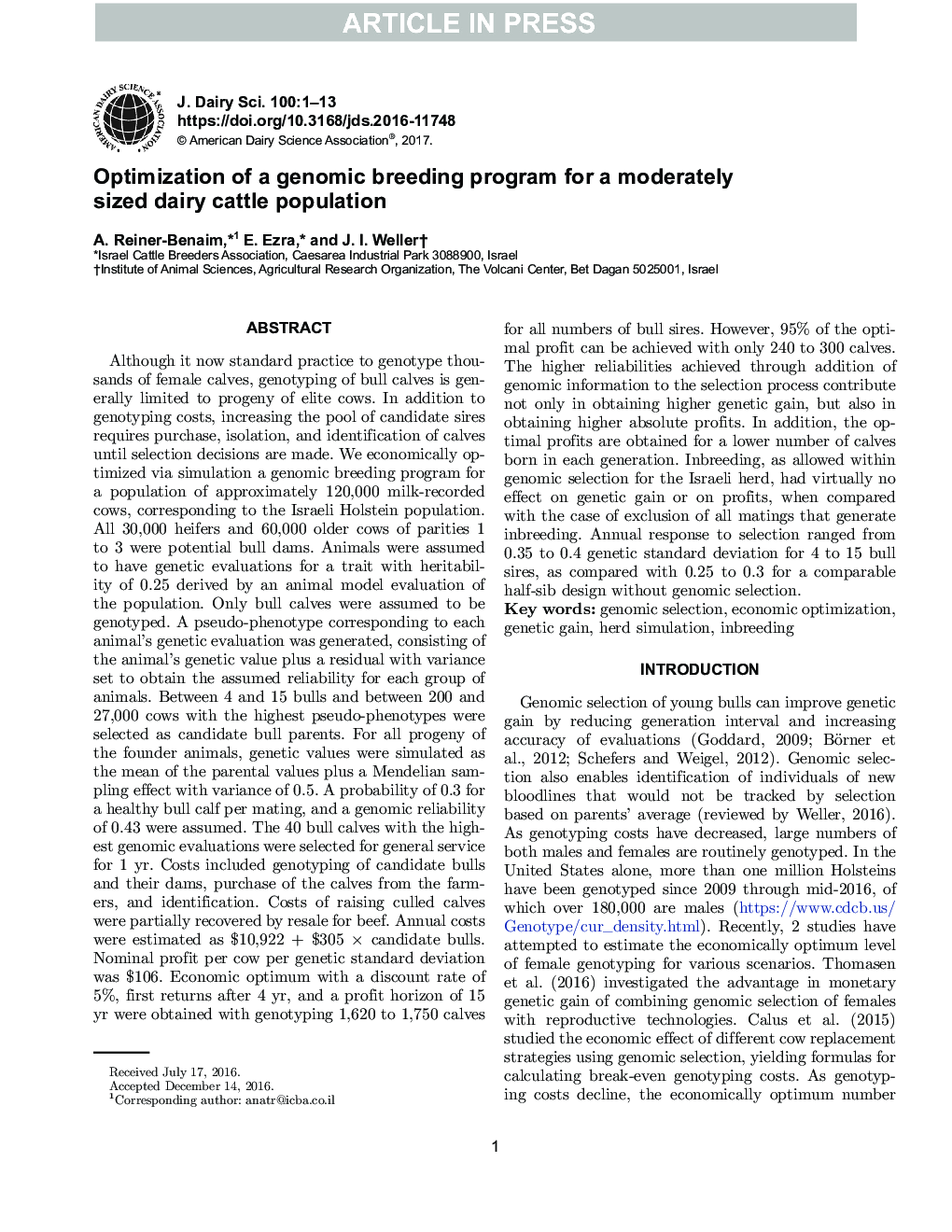| کد مقاله | کد نشریه | سال انتشار | مقاله انگلیسی | نسخه تمام متن |
|---|---|---|---|---|
| 5542344 | 1402517 | 2017 | 13 صفحه PDF | دانلود رایگان |
عنوان انگلیسی مقاله ISI
Optimization of a genomic breeding program for a moderately sized dairy cattle population
ترجمه فارسی عنوان
بهینه سازی یک برنامه پرورش ژنتیکی برای جمعیت گاوهای لبنی متوسط
دانلود مقاله + سفارش ترجمه
دانلود مقاله ISI انگلیسی
رایگان برای ایرانیان
کلمات کلیدی
انتخاب ژنوم، بهینه سازی اقتصادی، به دست آوردن ژنتیک، شبیه سازی گله، همبستگی،
موضوعات مرتبط
علوم زیستی و بیوفناوری
علوم کشاورزی و بیولوژیک
علوم دامی و جانورشناسی
چکیده انگلیسی
Although it now standard practice to genotype thousands of female calves, genotyping of bull calves is generally limited to progeny of elite cows. In addition to genotyping costs, increasing the pool of candidate sires requires purchase, isolation, and identification of calves until selection decisions are made. We economically optimized via simulation a genomic breeding program for a population of approximately 120,000 milk-recorded cows, corresponding to the Israeli Holstein population. All 30,000 heifers and 60,000 older cows of parities 1 to 3 were potential bull dams. Animals were assumed to have genetic evaluations for a trait with heritability of 0.25 derived by an animal model evaluation of the population. Only bull calves were assumed to be genotyped. A pseudo-phenotype corresponding to each animal's genetic evaluation was generated, consisting of the animal's genetic value plus a residual with variance set to obtain the assumed reliability for each group of animals. Between 4 and 15 bulls and between 200 and 27,000 cows with the highest pseudo-phenotypes were selected as candidate bull parents. For all progeny of the founder animals, genetic values were simulated as the mean of the parental values plus a Mendelian sampling effect with variance of 0.5. A probability of 0.3 for a healthy bull calf per mating, and a genomic reliability of 0.43 were assumed. The 40 bull calves with the highest genomic evaluations were selected for general service for 1 yr. Costs included genotyping of candidate bulls and their dams, purchase of the calves from the farmers, and identification. Costs of raising culled calves were partially recovered by resale for beef. Annual costs were estimated as $10,922 + $305 Ã candidate bulls. Nominal profit per cow per genetic standard deviation was $106. Economic optimum with a discount rate of 5%, first returns after 4 yr, and a profit horizon of 15 yr were obtained with genotyping 1,620 to 1,750 calves for all numbers of bull sires. However, 95% of the optimal profit can be achieved with only 240 to 300 calves. The higher reliabilities achieved through addition of genomic information to the selection process contribute not only in obtaining higher genetic gain, but also in obtaining higher absolute profits. In addition, the optimal profits are obtained for a lower number of calves born in each generation. Inbreeding, as allowed within genomic selection for the Israeli herd, had virtually no effect on genetic gain or on profits, when compared with the case of exclusion of all matings that generate inbreeding. Annual response to selection ranged from 0.35 to 0.4 genetic standard deviation for 4 to 15 bull sires, as compared with 0.25 to 0.3 for a comparable half-sib design without genomic selection.
ناشر
Database: Elsevier - ScienceDirect (ساینس دایرکت)
Journal: Journal of Dairy Science - Volume 100, Issue 4, April 2017, Pages 2892-2904
Journal: Journal of Dairy Science - Volume 100, Issue 4, April 2017, Pages 2892-2904
نویسندگان
A. Reiner-Benaim, E. Ezra, J.I. Weller,
